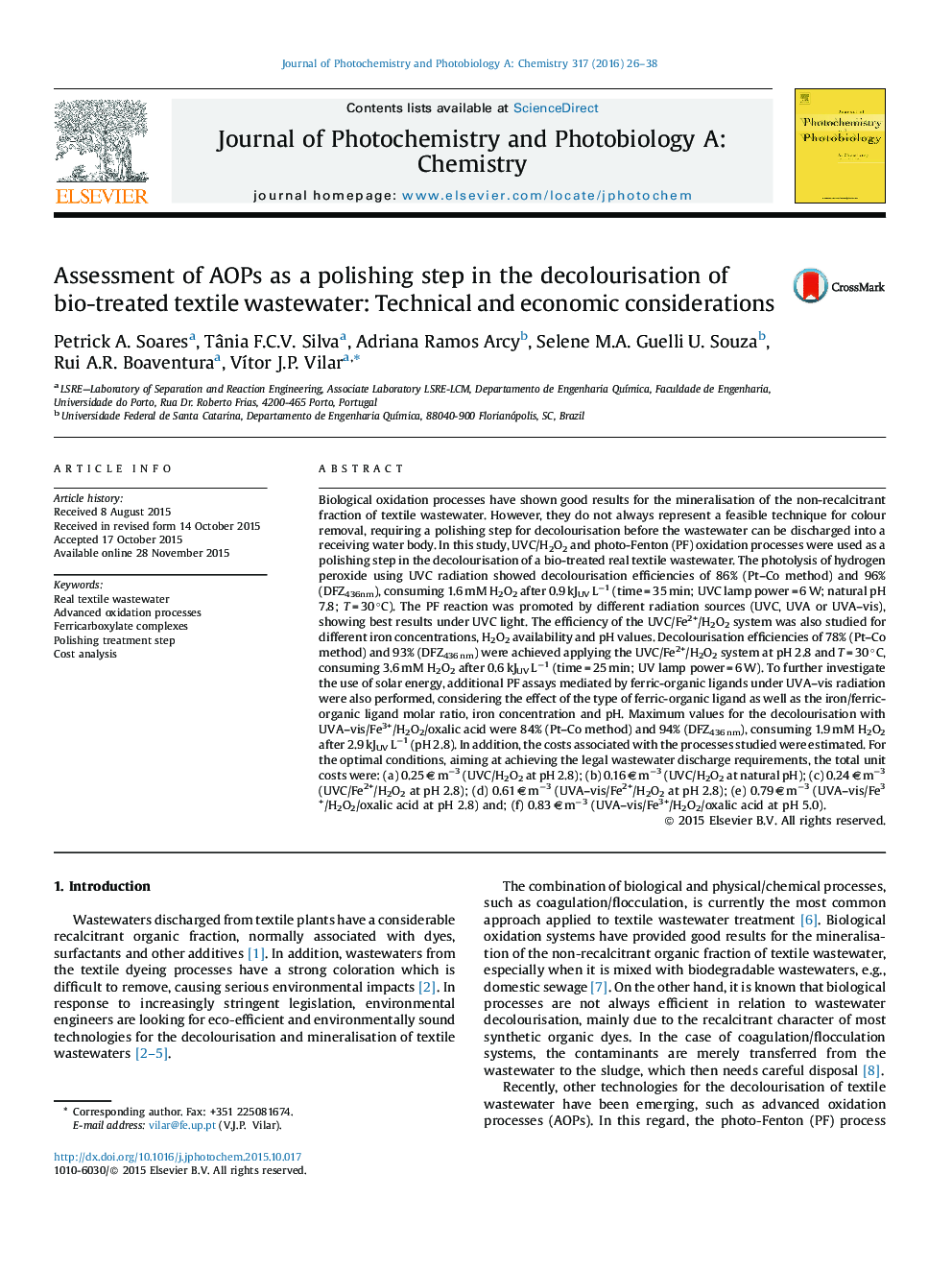| کد مقاله | کد نشریه | سال انتشار | مقاله انگلیسی | نسخه تمام متن |
|---|---|---|---|---|
| 26339 | 43948 | 2016 | 13 صفحه PDF | دانلود رایگان |

• UVC/H2O2 and photo-Fenton (PF) oxidation of bio-treated textile wastewater.
• The photolysis of H2O2 using UVC radiation showed high decolourisation rates.
• The photo-Fenton reaction was enhanced under UVC radiation.
• The addition of oxalic acid enhanced the PF reaction under UVA–vis light.
• The UVC/H2O2 system is cheaper than solar photo-Fenton process.
Biological oxidation processes have shown good results for the mineralisation of the non-recalcitrant fraction of textile wastewater. However, they do not always represent a feasible technique for colour removal, requiring a polishing step for decolourisation before the wastewater can be discharged into a receiving water body. In this study, UVC/H2O2 and photo-Fenton (PF) oxidation processes were used as a polishing step in the decolourisation of a bio-treated real textile wastewater. The photolysis of hydrogen peroxide using UVC radiation showed decolourisation efficiencies of 86% (Pt–Co method) and 96% (DFZ436nm), consuming 1.6 mM H2O2 after 0.9 kJUV L−1 (time = 35 min; UVC lamp power = 6 W; natural pH 7.8; T = 30 °C). The PF reaction was promoted by different radiation sources (UVC, UVA or UVA–vis), showing best results under UVC light. The efficiency of the UVC/Fe2+/H2O2 system was also studied for different iron concentrations, H2O2 availability and pH values. Decolourisation efficiencies of 78% (Pt–Co method) and 93% (DFZ436 nm) were achieved applying the UVC/Fe2+/H2O2 system at pH 2.8 and T = 30 °C, consuming 3.6 mM H2O2 after 0.6 kJUV L−1 (time = 25 min; UV lamp power = 6 W). To further investigate the use of solar energy, additional PF assays mediated by ferric-organic ligands under UVA–vis radiation were also performed, considering the effect of the type of ferric-organic ligand as well as the iron/ferric-organic ligand molar ratio, iron concentration and pH. Maximum values for the decolourisation with UVA–vis/Fe3+/H2O2/oxalic acid were 84% (Pt–Co method) and 94% (DFZ436 nm), consuming 1.9 mM H2O2 after 2.9 kJUV L−1 (pH 2.8). In addition, the costs associated with the processes studied were estimated. For the optimal conditions, aiming at achieving the legal wastewater discharge requirements, the total unit costs were: (a) 0.25 € m−3 (UVC/H2O2 at pH 2.8); (b) 0.16 € m−3 (UVC/H2O2 at natural pH); (c) 0.24 € m−3 (UVC/Fe2+/H2O2 at pH 2.8); (d) 0.61 € m−3 (UVA–vis/Fe2+/H2O2 at pH 2.8); (e) 0.79 € m−3 (UVA–vis/Fe3+/H2O2/oxalic acid at pH 2.8) and; (f) 0.83 € m−3 (UVA–vis/Fe3+/H2O2/oxalic acid at pH 5.0).
Figure optionsDownload as PowerPoint slide
Journal: Journal of Photochemistry and Photobiology A: Chemistry - Volume 317, 15 February 2016, Pages 26–38